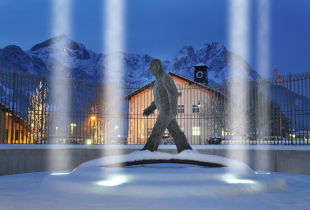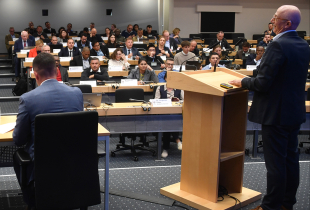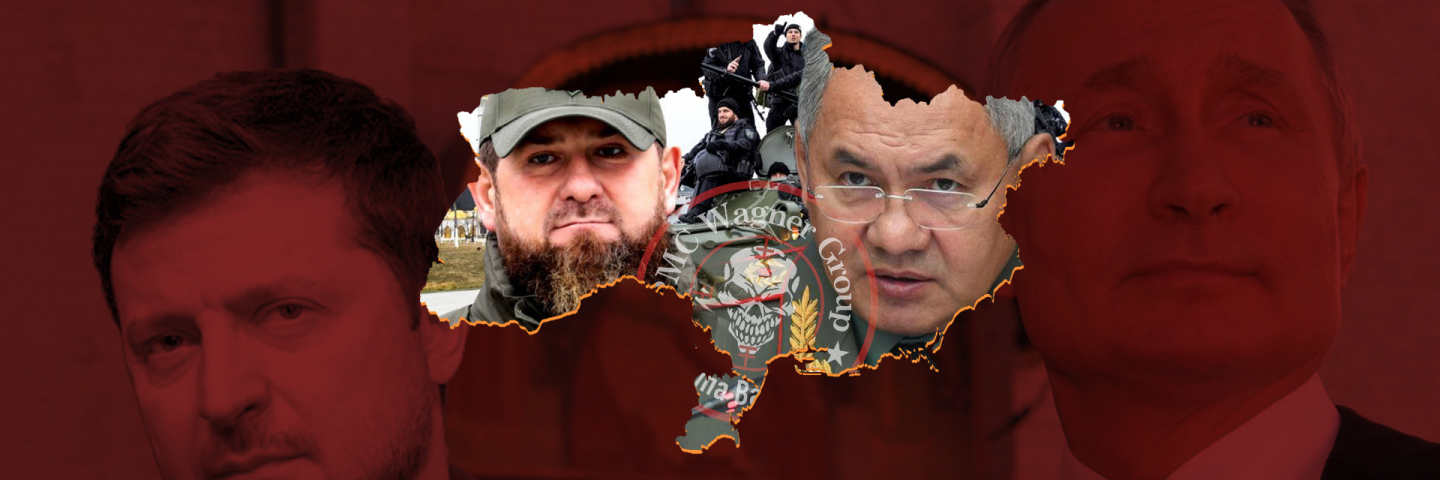
Militaries, Mercenaries, Militias, Morale, and the Ukraine War
Introduction
This year our Strategic Competition Seminar Series (FY23 SCSS) activities focus on the theme of alternative Ukrainian future trajectories and the implications these may have for Russia and the West. To this end, SCSS#2 identified and explored the impact of multiple militaries on Russia’s war fighting effort in Ukraine. Has Russia achieved ‘unity of command’ with the appointment of Gen Surovikin to overall commander of Russian forces fighting in Ukraine? How does theory of unified command differ from practice? What are the operational effectiveness implications of discrepancies between the two?
Russia’s Formal Chain of Command
The integrity of Russia’s military command is a constant issue. Russia’s multi-axis military invasion of Ukraine, initiated at 0400 CET on 24 February 2022, was led by multiple commanders. In October 2022 Gen Surovikin was appointed top Russian commander. However, unity of command has not appreciably strengthened. On paper Russia adopts a formal chain of unified command of the Russia Group of Forces for Special Military Operation in Ukraine. Gen Surovikin is the unified commander and as such is ultimately responsible for any resultant loss of operational effectiveness. Figure 1 outlines how in theory Russia’s formal chain of command should operate in Ukraine.
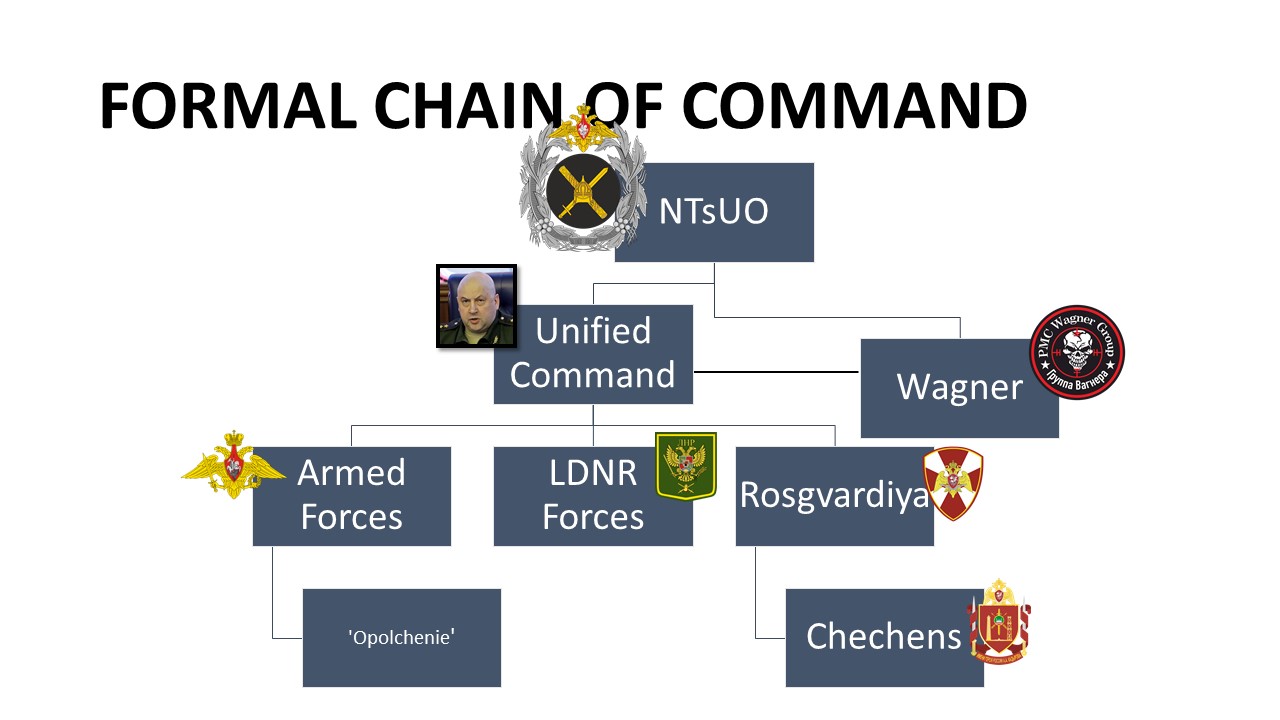
We can see that a wide variety of military actors are subordinated within this unified chain of command. It is difficult to verify with certainty thee current numbers of these actors as figures regarding ‘attrition rates’ and reconstitution with mobilized troops are not readily available. Approximations can be made and, given this, we should focus less on the exact figures and more on the relative balance between different units.
- Regular Military: c. 80,000 (?)
- Luhansk and Donetsk Peoples Republic (LDNR) Forces: c. 20,000 – these forces, the so-called 1st and 2nd Corps are very depleted and have been formally annexed into Russia’s regular military
- Opolcheniye (Militia): 3,000-13,000 (low/mid-range i.e. 5-6k likely)
- Wagner PMC: 1,000-8,000 (higher end likely) – heavy casualties but are also being reconstituted through a recruitment drive, including of Russian prisoners
- Rosgvardiya (National Guard): c. 17,000 (?) – includes elite OMON and other interior troops
- Chechens: 4-6 ‘battalions’ – 2,000-12,000 (lower end likely) – are formally supported to Rosgvardiya
The Real Chain of Command
The Russian chain of command that appears to operate in practice in Ukraine is more chaotic and fragmentary than the theory suggests. This introduces needless friction into cooperation between different units and branches, limiting combined arms efforts, mutual logistical support and so operational effectiveness. Figure 2 highlights how in practice Russia’s informal chain of command does operate in Ukraine.
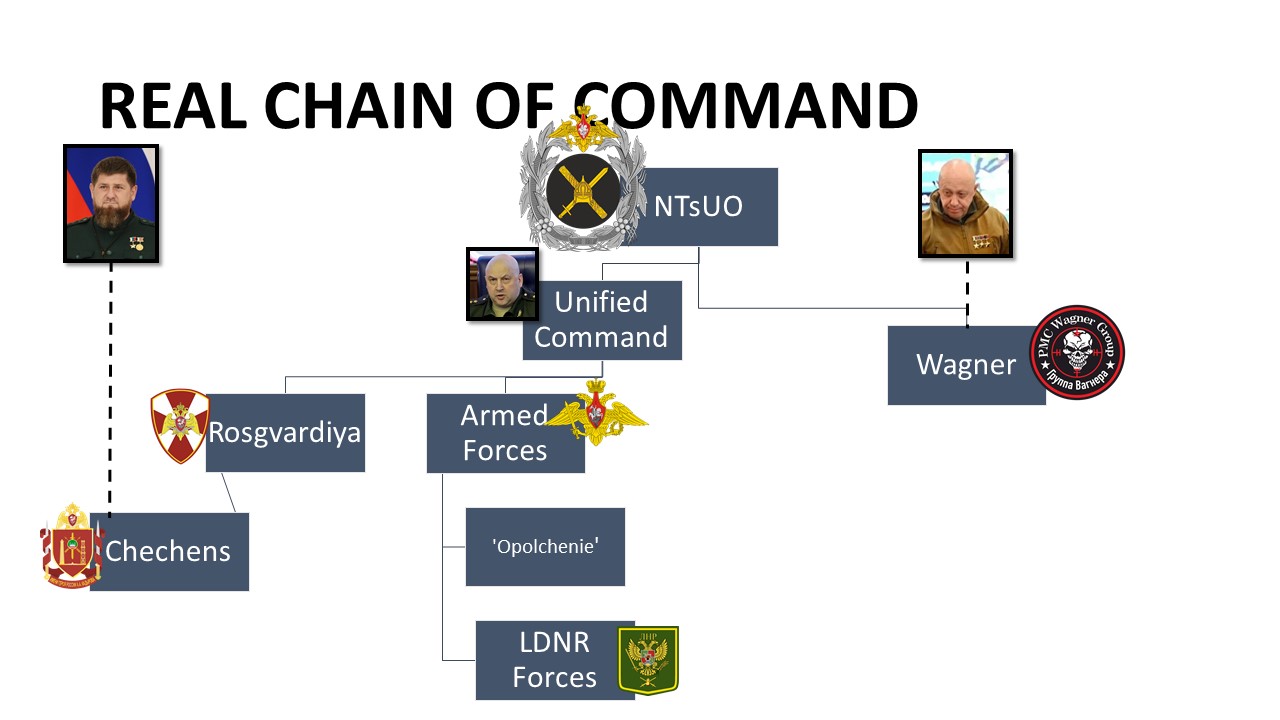
What are the notable differences between theory and practice?
- Wagner PMC is directly subordinated to Prigozhin and his military coordination cell. Gen Surovikin and the General Staff (the unified command) can request of Wagner troops but Prigozhin’s approval is needed as subordination to unified command would lead to the integration of Wagner into the regular military (institutionalization or ‘empire building’) leading to a loss of autonomy and control over his PMC for at least the duration of an open-ended conflict.
- Chechen forces in theory are subordinated to Rosgvardiya which in turn reports to the unified command. In practice, as with Wagner and Prigozhin, Kadyrov has direct control over his Kadyrovsky and counter-confirmation is needed if these units are ordered to change location. This de facto veto power adds time and friction to the decision-making and implementation process and so increases dysfunction on battlefield.
- Rosgvardiya units should be directly subordinated under the unified command. However, Zolotov has to counter-confirm major engagement and relocation orders, if only because Rosgvardiya commanders in Ukraine seek permission to avoid exposure. As with the other caveats, added time and friction hampers the operational effectiveness of Russian forces – bitter competition over fuel and other necessary supplies and logistics.
- LNR and DNR militias are in theory integrated into the regular Russian military, and this in fact largely reflects practice.
Implications for Russian Military Operations
Russia’s ‘Unified Command’ is not unified and does not therefore command as it should. This lack of unity only exacerbates friction between the regular military, Rosgvardiya, Wagner, Kadyrovsky, and militias. While it is difficult to assess the potential in combat effect if Russia would be able to realign its fragmented command structure, we can note shortcomings that arise from the current state of affairs.
- Outright conflict: there is suspicion that Wagner’s months long grinding assault on Bakhmut, strategic value, represents a means of the regular Russian military to control Wagner. However, given Wagner fights alongside the Marine Brigade of the Pacific Fleet (itself supplemented by newly mobilized middle-aged men), ‘disciplining’ and subordinating Wagner cannot be the whole story.
- Fragmented morale: it is harder to make broader assumptions about Russian morale as morale is not always fixed but can change. Factors such as logistics support, C3, battlefield losses and withdrawals, winter temperatures, and the falling quality of Russian officers all play a role. Officers are a key factor in whether troops stand and fight – unlikely if their officers are the first to run. Morale plummets if officers do not engender trust in the chain of command, issue incomprehensible orders, and are drunk. Fragmented morale may mitigate the possibility of a cascading collapse of morale, a culmination point.
- Poor coordination and logistical support: weak communication hampers the provision of logistical support (for example, artillery ammunition and fuel for close air support operations), which is critical to enabling not just Russian combined arms offensive operations, but also defending territory. Lack of logistical support also further drains morale. Ukrainian coordination appears by contrast fluid, allow for vertical and horizontal exchanges, integration, and adaptation.
From Symptoms to Causes and Future Trends
The current fragmented command structure reflects the political fundamentals of the Russian state. To put it another way, where power lies on the battlefield is where power in Moscow. President Putin creates checks and balances through non-institutionalized fragmentation so that groups compete against each other and he can exercise arbitration power and uphold a necessary function in the system. Added to this, the divergent competitive goals (desire to optimize revenues, recruit best personnel, define mission and narrative) of these sub-institutional actors promotes clashes. Putin’s ‘power vertical’ is a fiction.
In addition, the more entrepreneurial Russian elements formally subordinated in the chain of command all have other functions in the Putinite system which legitimizes their autonomy. Kadyrov’s independent standing is seen as necessary to avoid a third Chechen war, even as Kadyrov seeks to instrumentalize involvement in the war to secure heavy weaponry for his light infantry forces, and prepare for life after Putin (his patron). Zolotov’s Rosgvardiya is all that stands between a ‘color revolution’ and the Kremlin, at least in the paranoid mindsets of Russia’s national security elite. Prigozhin’s utility stems from being a fixer - Wagner offers the possibility of quick fix solutions. Like Kadyrov, Prigozhin is a ‘conflict entrepreneur,’ seeking to monetize conflict (governors outsource the training of her militias to Wagner) and privatize the profits from ‘patriotic public service.’
Prigozhin is an oligarch of the third order and lacks unlimited funds. The opaqueness regarding the military men around him and his own command structure leads to a questioning of his standing: is he a front and mouthpiece? If so, for whom? Is it the GRU? Some have speculated that it is the GRU, basing this understanding on Wagner’s genesis in 2014-15 in Donbas and Syria. However, the GRU is tasked to operate spetsnaz behind enemy lines (not in evidence in Ukraine), not police or Wagner. Moreover, Prigozhin publicly denigrates the competence of Russia’s General Staff (GRU is subordinated to the GenStaff), the performance of individual Russian Generals (Lapin) and professionalism of Defense Minister Shoigu. Such verbal tirades are hardly indicative of GRU ‘control’ over Wagner. The SVR focuses on gathering political (assessing political will) and technical intelligence where it can in the West and so is not a contender. The FSB’s military counter-intelligence directorate monitors the Russian military, and therefore Prigozhin and Wagner will, formally at least, fall under their oversight.
Russia seeks to avoid losing the war and this means dragging the conflict out to allow for reconstitution. Time therefore may institutionalize the actual current operating chain of command and improve its functioning. Russia’s reliance on a wide variety of military actors appears dysfunctional but is this offset by the benefits of greater force generation? Although mobilization should have strengthened manpower of the regular army, it is not clear if this is the case. Certainly though, the regular military increases in size relative to militias, which are subsumed within it, not to say cannibalized. It is a mistake to underestimate Russian capacity to cope with dysfunctionality. It is also possible that Russia slowly learns from the Syrian example and experience of coalitional warfare: “Managing the Chechens is like getting Hezbollah to follow the plan.”
Looking to the future, current attrition rates coupled with sanctions and technology controls, suggest it will take at least 10 years to reconstitute the Russian military. How Russia reconstitutes will all depend on who is Russia’s political leader and the mission they set the military, particularly with regards Europe and Eurasia. Politics will have primacy. The reconstitution slogan may well be “build back better” but the reality will be “build back basics,” first and foremost regarding a force structure fit for purpose and a functioning chain of command.
GCMC, 19 October 2022
About the Authors
Dr. Mark Galeotti is director of the London-based consultancy Mayak Intelligence, an honorary professor at the University College London School of Slavonic and East European Studies, a senior associate fellow at the Royal United Services Institute, and a senior non-resident fellow at the Institute of International Relations Prague. He is an expert and prolific author on transnational crime and Russian security affairs.
Dr. Pavel K. Baev is a Research Professor at the Peace Research Institute Oslo (PRIO). He is also a Senior Non-Resident Scholar at the Brookings Institutions (Washington, DC) and a Senior Research Associate with the French International Affairs Institute (IFRI, Paris). Pavel specializes in Russian military reform; Russian conflict management in the Caucasus and Central Asia; energy interests in Russia’s foreign policy; and Russian relations with Europe and NATO.
Dr. Graeme P. Herd is a Professor of Transnational Security Studies in the Research and Policy Analysis Department at the George C. Marshall European Center for Security Studies. His latest books include Understanding Russia’s Strategic Behavior: Imperial Strategic Culture and Putin’s Operational Code (London and New York, Routledge, 2022) and Russia’s Global Reach: A Security and Statecraft Assessment, ed. Graeme P. Herd (Garmisch-Partenkirchen: George C. Marshall European Center for Security Studies, 2021).
The George C. Marshall European Center for Security Studies
The George C. Marshall European Center for Security Studies in Garmisch-Partenkirchen, Germany is a German-American partnership and trusted global network promoting common values and advancing collaborative geostrategic solutions. The Marshall Center’s mission to educate, engage, and empower security partners to collectively affect regional, transnational, and global challenges is achieved through programs designed to promote peaceful, whole of government approaches to address today’s most pressing security challenges. Since its creation in 1992, the Marshall Center’s alumni network has grown to include over 15,000 professionals from 157 countries. More information on the Marshall Center can be found online at www.marshallcenter.org.
The Clock Tower Security Series provides short summaries of Seminar Series hosted by the George C. Marshall European Center for Security Studies. These summaries capture key analytical points from the events and serve as a useful tool for policy makers, practitioners, and academics.
This Clock Tower Security Series summary reflects the views of the authors (Mark Galeotti and Graeme P. Herd) and is not necessarily the official policy of NATO, the United States, Germany, or any other governments.
